Color Psychology Statistics By Color, Demographics, Country, Preferences, Brand and Purchasing Habits
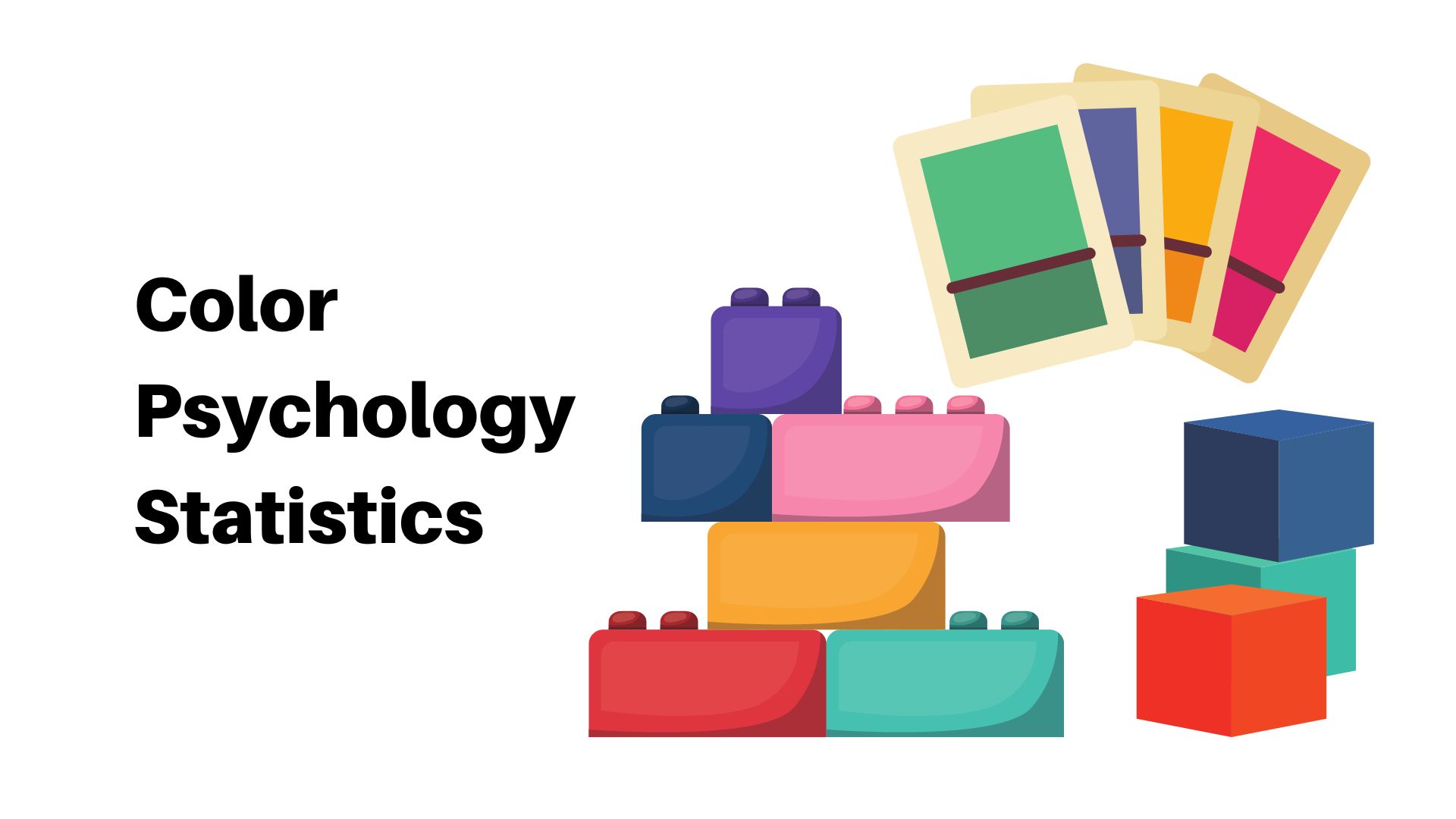
Page Contents
- Introduction
- Editor’s Choice
- What is Color Psychology?
- Different Colors and Their Features
- Facts About Color Psychology
- General Color Psychology Statistics
- Color Psychology Statistics by Color
- Color Psychology Statistics by Demographics
- Color Psychology Statistics by Purchasing Habits
- Color Psychology Statistics by Country
- Color Psychology Statistics by Affecting Factors on the Website
- Color Psychology Statistics by Preferences
- Color Psychology Statistics by Brand
- Conclusion
Introduction
Color Psychology Statistics: Colors make a difference! Today is the most difficult stage to attract consumers in offline as well as online marketing. Therefore, colors in branding play an important role to promote the product and attract more customers to the company. Color Psychology Statistics states, even if people forget about the brand name, they still remember the logo and its color even after years. While we set brand colors, the nature of the product and its characteristics should be considered as color is the one representing the whole product in the sea of millions of other products. Check out the below statistics with exclusive content written along with colors and their features.
Editor’s Choice
- 39% of the users on the internet are more attracted to colors on the website than any other visuals.
- 62% to 90% of the consumers make a judgment about the brand and product within 90 seconds based on the color.
- In the United States of America, the top 5 favorite colors are Blue (35%), Green (16%), Purple (10%), Red (9%), and Yellow (5%).
- There are some people around the world who have a color phobia called Chromophiba or Chromatophobia.
- 2 out of 3 consumers are less likely to purchase a particular product if it doesn’t come in the color they prefer.
- On average, women are more likely to understand differentiations in colors than men while men are more likely to be associated with color blindness.
- According to Fortune 500 Logos, blue is the most popular color as it was associated with 40% of the logos in the list.
- Call to Actions buttons in Red color are 34% more likely to increase sales and conversations.
- Color Psychology Statistics confirm that red, orange, black, and royal blue attract impulsive shoppers in outlet malls, fast food stations, and clearance sales.
- Heinz the ketchup brand changed its brand color and experienced a $23 million increase in overall sales.
What is Color Psychology?
Color Psychology is a study that proves how any color affects the perception, emotions, and behavior of humans. Different colors have different qualities which creates natural emotions in the mind of a human. Color affects differently in all genders, age groups, cultures, and generations. Considering the Color perception in cultural terms, it may have two opposite meanings such as, in foreign countries White color is worn during Weddings, while in India white is associated with death. On the other hand, black is associated with death in most of the countries. Following are some of the colors and their features.
Different Colors and Their Features
Black
- Black color represents positive emotions such as sophistication, authority, elegance, security, and power.
- Whereas, it represents mourning, depression, oppression, heaviness, and coldness as negative feelings.
- The companies use this color to sell exclusive and glossy products.
- Brand examples: L’Oréal, New York Times.
Gold
- Gold color represents wisdom, charisma, success, and optimism whereas it also showcases demanding and self-centeredness in a negative sense.
- It is commonly represented during sports events moreover, it is related to religion as well as royalty.
- Brand Examples: Porsche, Rolex.
Yellow
- Yellow color is known for intellect, happiness, warmth, and creativity.
- On the other hand, in the sense of negative emotions, it showcases irrationality, anxiety, fear, caution, and frustration.
- This color is commonly shown in emojis.
- Brand examples: BIC, and Nikon.
Green
- This color is associated with positive emotions such as balance, harmony, nature, health, hope, and growth.
- Whereas, in the sense of negative emotions, it showcases materialism, boredom, and possessiveness.
- This color is used by the military, and banking sectors to showcase power and wealth.
- Brand examples: Animal Planet, John Deere
White
- White is associated with cleanliness, simplicity, and innocence whereas it also represents coldness, emptiness, and caution.
- Brand examples: Tesla, Apple, and Zara.
Orange
- Orange showcases warmth, cheerfulness, energy, friendliness, energy, and innovation whereas it also represents ignorance, laziness, frustration, and ignorance.
- Brand Examples: Nickelodeon and TNT.
Magenta
- Magenta is often associated with positive emotions such as creativity, quirkiness, passion, and On the other hand, it also showcases rebelliousness, and impulsiveness.
- This color is mostly used to represent youth and femininity.
- Brand examples: Cosmopolitan Magazine
Brown
- Brown color represents safety, sophistication, strength, and security in terms of positive emotions.
- On the other hand, brown is associated with isolation, loneliness, and sadness.
- Brands use this color in their food packaging to showcase that the food is natural, eco-friendly, and organic.
- Brand Examples, J.P. Morgan Chase Hershey’s, and UPS.
Blue
- Blue showcases security, logic, serenity, and trust whereas it features unappetizing, unfriendly, coldness, and emotionlessness.
- Brand Examples: LinkedIn and American Express
Red
- The color red is commonly represented by energy, fearlessness, power, and passion, whereas it also represents anger, pain, hostility, and aggression in a negative sense.
- Brand Examples: KFC, McDonald's
Purple
- Purple represents sophistication, imagination, wealth, and spirituality whereas it is also associated with hostility, anger, pain, and aggression.
- Brand Examples: Cadbury
Facts About Color Psychology
- Blue is the most common favorite color around the world for all genders and generations.
- There are some people around the world who have a color phobia called Chromophiba or Chromatophobia.
- Heinz the ketchup brand changed its brand color and experienced a $23 million increase in overall sales.
- Colors such as red and yellow seen together will make you hungry.
- The first-ever color seen by a baby is Red.
- Wearing black makes you look powerful and rich.
- The color red is seen differently by women and men.
General Color Psychology Statistics
- Business is 80% more likely to receive brand recognition when signature color is used.
- 78% of the people remember brand colors whereas only 43% of consumers know brand names.
- Color provides 90% of the first impression about a brand and the product.
- Using an exact color in a brand is 40% more likely to improve the attention of customers toward the company.
- Ads in color get 42% more impressions than ads in black and white.
- 83% of small-scale businesses believe that brand colors make them showcase being more successful.
- 39% of the users on the internet are more attracted to colors on the website than any other visuals.
Color Psychology Statistics by Color
- The most common least favorite colors are brown 23% and orange 29%.
- 95% of the top 100 brands apply only one or two colors in their logos.
- According to Fortune 500 Logos, blue is the most popular color as it was associated with 40% of the logos in the list.
- Call to Actions buttons in Red color are 34% more likely to increase sales and conversations.
- 62% to 90% of the consumers make a judgment about the brand and product within 90 seconds based on the color.
- In the United States of America, the top 5 favorite colors are Blue (35%), Green (16%), Purple (10%), Red (9%), and Yellow (5%).
- Black color is more popular in high-end and luxury brands.
- Colors such as Gray, Blue, Black, White, and light brown are viewed as unisex colors.
- 29% of the world’s most recognizable companies have red as their primary color.
- 28% of the companies use gray and black colors for their branding.
- Blue, Yellow, and Red are termed as primary colors while purple, green, and orange are termed as secondary colors.
- Furthermore, Color Psychology Statistics confirm that red, orange, black, and royal blue attract impulsive shoppers in outlet malls, fast food stations, and clearance sales.
- Whereas, Navy blue and teal colors attract shoppers on a budget in larger department stores and in banks.
- In addition, pink, rose, and sky blue attract traditional buyers in clothing stores.
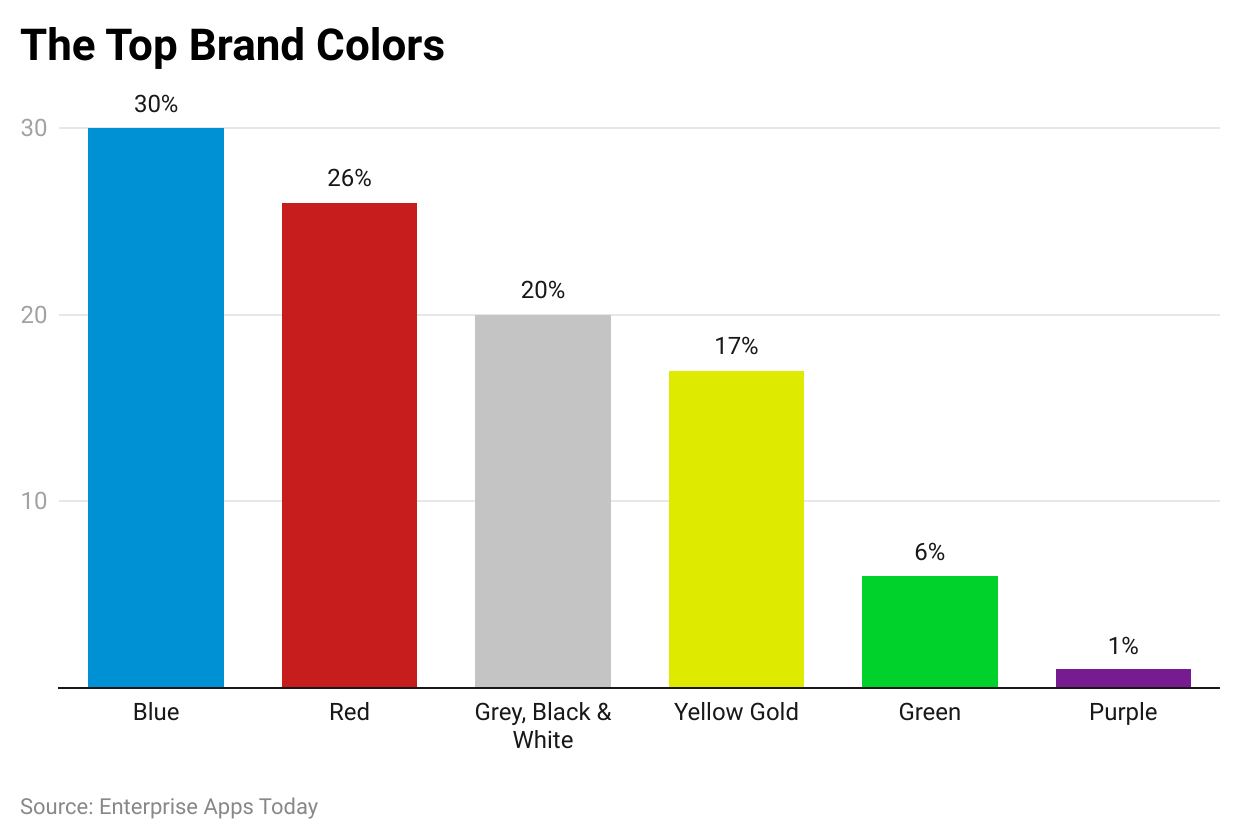
(Reference: visme.co)
- According to Forbes’ list of the world’s most powerful brands, blue ranked the most powerful resulting in 30%.
- Furthermore, it is followed by Red (26%) and Gray, Black ad White equally at (20%).
- Yellow and Gold similarly ranked fourth with 17%.
- Whereas Green and Purple are the least powerful resulting in 6% and 1% respectively.
Color Psychology Statistics by Demographics
- Color Psychology Statistics state that around 0.5% of women and 8% of men are colorblind but, blue color is seen by everyone including people struggling with colorblind problems.
- Men prefer bright shades of the colors whereas women prefer light colors.
- On average, women are more likely to understand differentiations in colors than men while men are more likely to be associated with color blindness.
By Age Group
Teenagers
- Age group: younger than 19 years
- Color preferences of Boys: Charcoal Black, Splashed White, and Denim blue
- Color preferences of Girls: Crimson Red, Tangerine Orange, Jade Black

(Reference: designmantic.com)
Young Adult
- Age group: between 20 to 30 years
- Color preferences of male: Carolina Blue, Hickory Brown, and Quartz Silver
- Color preferences of females: Cherry Red, Eggplant Purple, and Sand Gold

(Source: designmantic.com)
Adults
- Age group: between 30 to 40 years
- Color preferences of male: Earl Grey, Powder blue, and Oxford Blue
- Color preferences of females: Dull Magenta, Heather Purple, and Emerald green

(Source: designmantic.com)
Middle Aged
- Age group: between 40 to 55 years
- Color preferences of male: Misty Grey, Smokey Teal, and Pebble Black
- Color preferences of females: Pantone plum, Pie Green and Apricot Pink

(Source: designmantic.com)
Senior Citizen
- Age group: 55 years and above
- Color preferences of male: Pale Beige, Snow blue, and Suave Mauve
- Color preferences of females: Crepe Pink, Candle White, Frosty Lime

(Source: designmantic.com)
By Gender
Most Favorite Colors for Men and Women
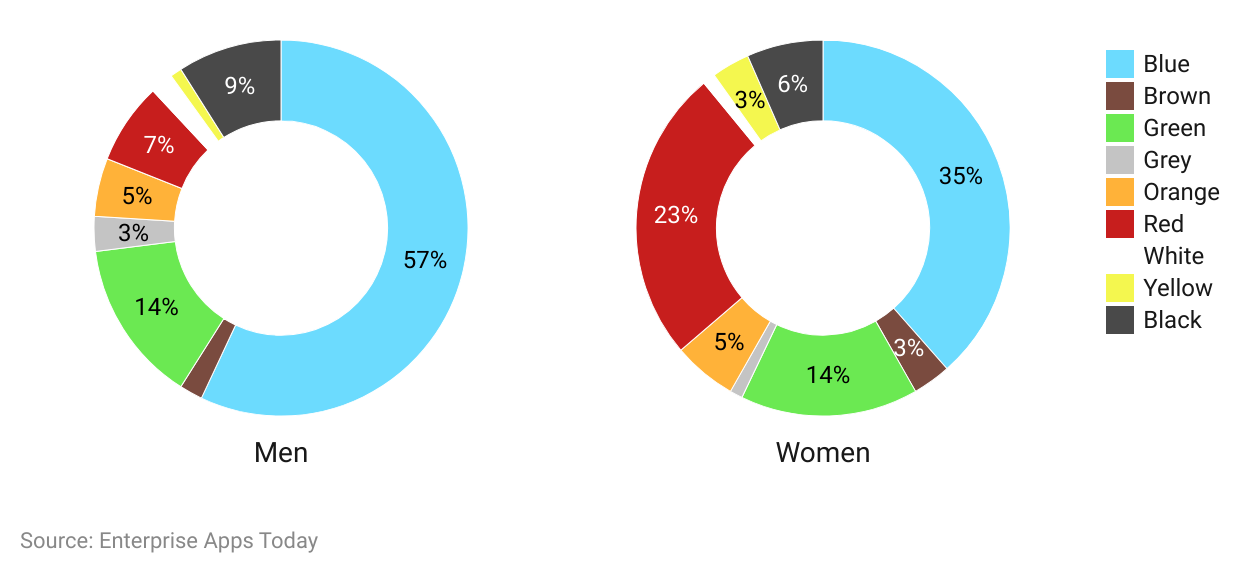
(Reference: smartinsights.com)
Least Favorite Color for Men and Women
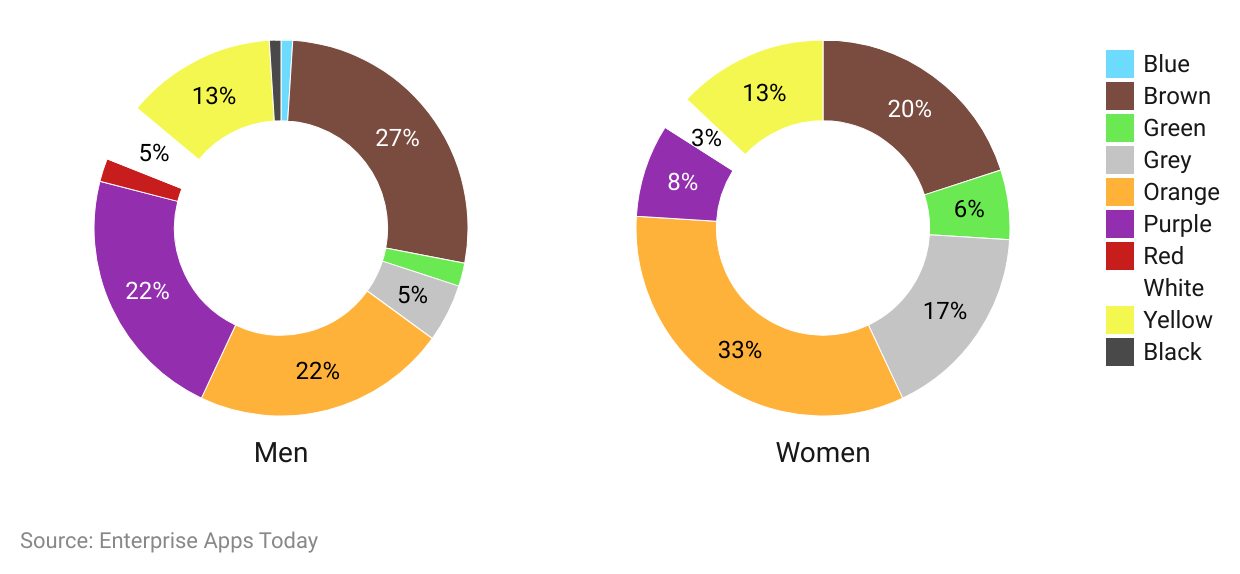
(Reference: smartinsights.com)
Color Psychology Statistics by Purchasing Habits
- 85% of the buyers purchase the product because of its color.
- 2 out of 3 consumers are less likely to purchase a particular product if it doesn’t come in the color they prefer.
Color Psychology Statistics by Country

(Source: bootcamp.uxdesign.cc)
Color Psychology Statistics by Affecting Factors on the Website
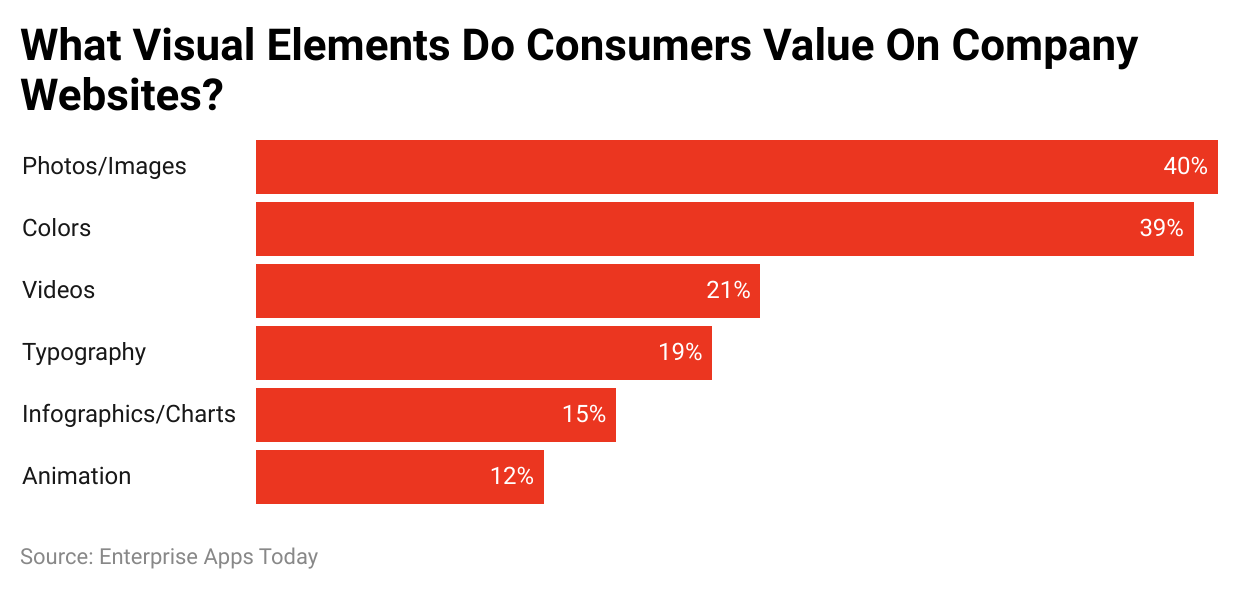
(Reference: colorlib.com)
- The most valued factors on a company website are photos/ images and colors resulting in 40% and 39% respectively.
- Other factors in the list are Videos (21%), Typography (19%), Infographics/Charts (15%), and Animation (12%).
Color Psychology Statistics by Preferences

(Reference: colorlib.com)
- According to Color Psychology Statistics, blue color is the most preferred color for business websites resulting in 46%.
- Whereas, Green and Red have reference rates of 30% and 22% respectively.
Color Psychology Statistics by Brand
The following chart explains the nature of the company by its applied color to the branding. Think in different terms, if we exchange colors of these brands, what kind of impression would that make in our minds? Do you think these brands have incorporated exact colors as the nature of the product?
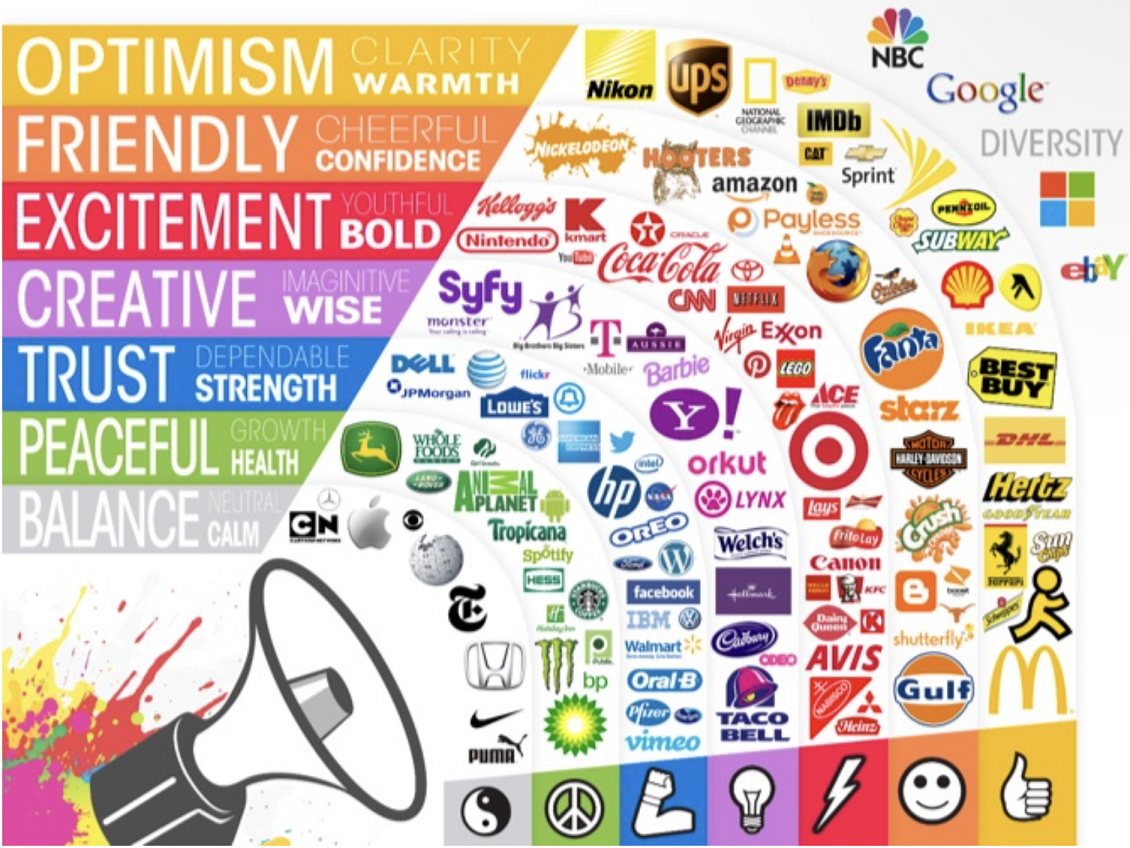
(Source: creativemarket.com)
Conclusion
Color is the most important factor in branding as it attracts various customers in the market. These Color Psychology Statistics prove that people may forget the brand name but they will recognize the color and the brand just by looking at it. Applying appropriate colors to exact branding is crucial. As stated by its characteristics, colors have different meanings, and therefore they represent the whole brand and the related products. Chosen colors should be so well fitted that they should make a positive impression at first sight. Just look at the above example of brands, even if there was no brand name, we would have anyways recognized it just by looking at its color and logo.
Sources
FAQ.
For determining the color for branding you should consider the nature of the company as well as the product.Moremover, keep in mind the cultural aspect in which the company is operating its business. Combine two colors and do not include too many aggressive brand colors.
Colors have some qualities which naturally create emotions in the human body. The effect may be different depending on the age, gender or generation and culture but each color affects differently to every individual person.The brain has associated some emotions with colors, therefore after seeing these colors we feel the relationship between color and psychology.
Color Psychology states that brand recognition is increased by 80% even if the brand name is forgotten. Colors provide a different framework of the brands which are incorporated into the minds of consumers. If we choose a color green for natural based products, then people will automatically know how the company is producing.
On a personal level, colors affect the moods and thoughts process of people. Moreover they can also trigger thoughts. For example, if the room has light and decent color, you will feel fresh the whole day, whereas, having a dark and aggressive color will make you angry and dull everyday.

By conducting scientific research, I write about illness, health and healthcare. As a professional medical writer, my experience includes creating feature articles for newsletters and websites as well as research news stories for doctors and researchers. Reading has been an integral part of me since childhood - I'm fan of "Friends" and the "Harry Potter series". Before this career, I was employed by a French multinational company. However, my passion for reading led me to pursue writing professionally; my first Amazon-published short story entitled "The envelope that changed our lives" has recently been released. In my free moments, I enjoy long bike rides around town.